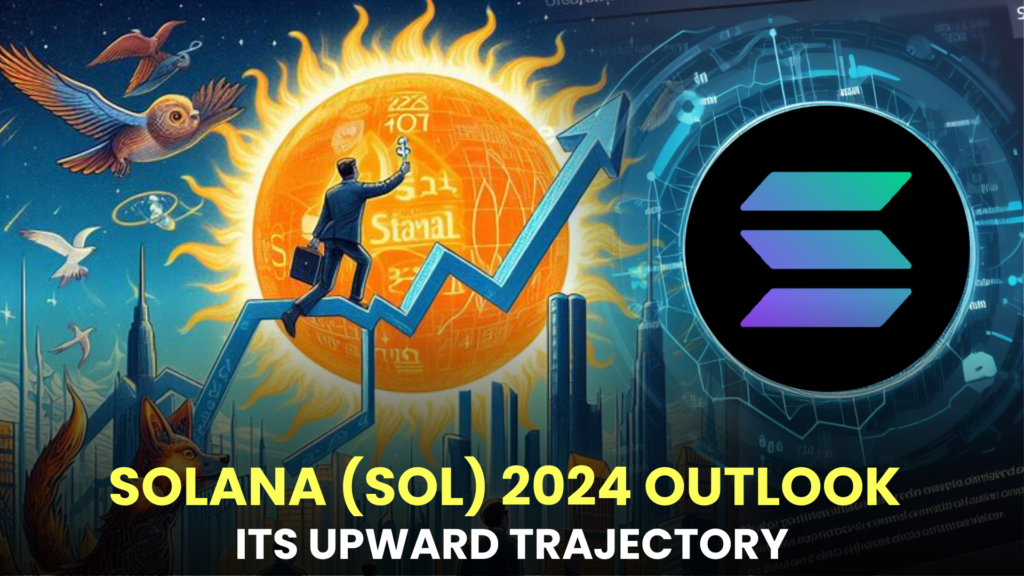Solana (SOL) 2024 Outlook
As we traverse into 2024, the trajectory of Solana becomes a pivotal question for the cryptocurrency market. A glance at the Solana chart reveals strong growth, followed by a recent phase of correction. The moving averages have aligned in a manner that suggests a strong bullish trend with the price consistently staying above these indicators.
However, SOL has recently experienced a pullback, hinting at a period of consolidation. This could be attributed to active profit-taking from venture capitalists (VCs), which was a foreseen event given the asset’s substantial appreciation over the past months. The retracement is also part of the natural market cycle following such an impressive rally.
The Solana ecosystem has seen significant growth, particularly in decentralized finance (DeFi) and the proliferation of meme coins. The rapid expansion of DeFi on Solana has been fueled by its high transaction throughput and relatively low fees, making it a competitive environment for DeFi applications.
The meme coin phenomenon has also found a foothold on Solana, attracting both positive attention for its viral nature and negative scrutiny due to the high magnitude of scams and market manipulations associated with this niche.
- Factors contributing to Solana’s visibility and adoption:
- Increased volatility
- Resilience tested by high-profile scams
- Skepticism among investors
Looking forward, for Solana to continue its upward path, the ecosystem will need to address these challenges head-on. Enhancements in security protocols, more rigorous vetting of projects, and an overall shift toward more sustainable and utility-driven applications will be critical.
The network’s capability to scale effectively, maintain uptime, and foster a secure environment for both DeFi and other applications will be key determinants of its trajectory.
Despite the current correction and associated challenges, the fundamentals of Solana, especially its blockchain’s architecture designed for speed and efficiency, remain strong. If the community and developers can collaborate to bolster the network’s robustness against scams and ensure a more stable platform, Solana has the potential to resume its upward trend.
The path forward for SOL will likely hinge on its ability to mature as an ecosystem, prioritizing security and long-term utility over the transient hype of meme coins and speculative ventures.
New Year for Ethereum
As Ethereum (ETH) steps into 2024, its market position appears to be on the cusp of transformation. The past year has seen significant developments within the Ethereum ecosystem, notably the expansion of Layer 2 (L2) networks and the unveiling of a refreshed road map by Vitalik Buterin, presenting a new vision for the platform.
These changes may have set the stage for a potential price reversal for Ethereum as it continues to navigate its current rally. The price chart of Ethereum indicates a mixed scenario. After a period of bullish trend, ETH is showing signs of consolidation. The moving averages are providing support at lower levels, and the price is oscillating around these key indicators, suggesting a balancing act between bullish optimism and bearish caution.
The L2 networks, like Arbitrum and Optimism, have been a beacon of growth, with transaction volume skyrocketing by 90 times compared to 2021. This incredible expansion signifies a shift in focus to scalability and efficiency. The L2 solutions are not just a technical improvement but also a strategic realignment, positioning Ethereum to better handle the burgeoning demands of DeFi, NFTs, and other blockchain applications.
Buterin’s new Ethereum vision, which emphasizes single slot finality, cross-rollup standards, and the inclusion of Verkle trees, points to a more secure, efficient, and scalable network. The road map update also hints at long-term improvements to Ethereum’s architecture, ensuring its place at the forefront of blockchain innovation.
Despite these promising developments, Ethereum’s price rally has been lagging when compared to some of its competitors. This underperformance could be due to market dynamics that have seen investors chase higher yields elsewhere. However, the solid rise in traction on L2 networks suggests that the groundwork is being laid for a more robust and expansive ecosystem.


